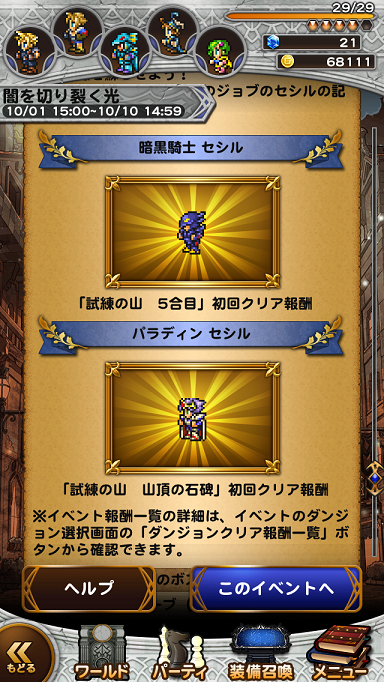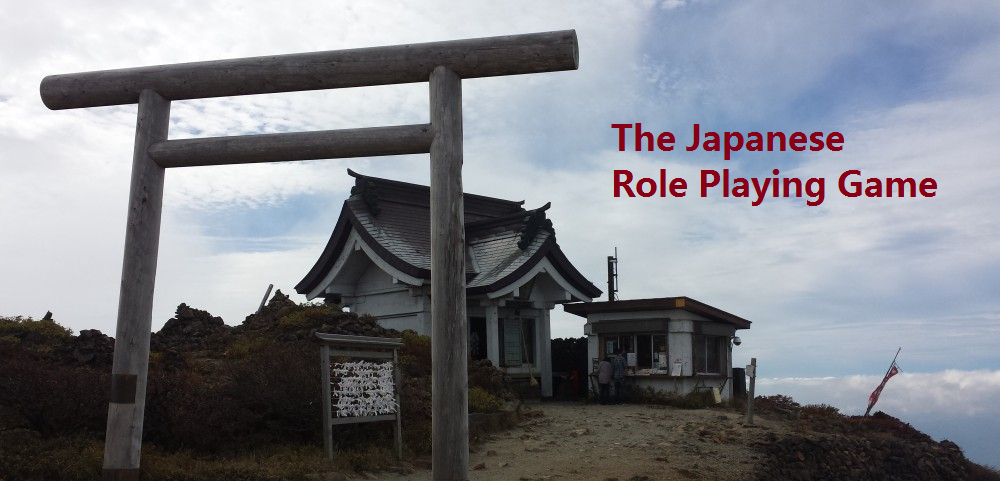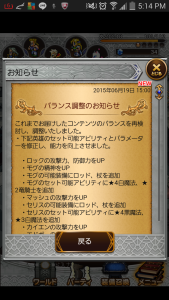
I mean, if you’re not already sold by having the prospect of TWO Cecils in your party, I don’t know what else I can do.
アップデートされているゲームの再バランスについて
Or, What Final Fantasy Record Keeper Does Right
Back In My Day
In those early days of uphill walking, not looking at the weather report, and making considerable mistakes in regards to footwear, video games were cut and dry on launch. Remakes and ports were rare (Sakaguchi mentions that he didn’t want to make them while at Square), and patches for games were almost nonexistent, especially in the console scene. When a game was released, it was done.
As a developer, this meant that games needed to be playtested thoroughly, and that everything needed to be done to make sure a game worked and worked well upon release. Thankfully, in that era, games had a fraction of the complexity they have now, and in regards to console games, never had to worry about what hardware they were running on. So developers could reasonably make a game, test it, and ship it, without having to consider what would happen when a software update causes a bug, or whether or not an update that someone suggests is even viable.
It’s done.
Nothing we can do about it.
A Complex World
Landscapes changed, however, and with the shift came more complex games and more ways to update games.
The internet (which arose alongside updating games, for obvious reasons) is awash with people nowadays who cry foul when games are released broken or problematic in areas. Criticism is a good thing on the whole, and the communication of bugs and other game-related problems has made games even more polished then their former counterparts.
What many people forget is how broken games were in the past. Look at lists of glitches for old games. There’s a lot of them! But there’s not much you could do about them except continue (or restart, if you had one of those glitches that ruined your save files; or quit). The number of games without bugs is small, and my guess is that most of those games are quite simple in design.
But games have continued to become more-and-more complex, and because of the updating nature, people have become less-and-less tolerant. Complaining didn’t do much with those old bug-filled games. Now, people have the means to express their qualms and reasonable expectation that those problems will be remedied.
Is it any surprise that Skyrim was filled with bugs? Is it any surprise any open-world game is? Given the complexity, I’m surprised at how few people experience problems. Or in the case of Skyrim (which I’m pretty sure everyone has experienced a bug), how few problems they experience. I’m glad that there are developers out there who are willing to tackle the open-world experience, because it sure as hell isn’t easy.
When someone types a rage-filled response to a developer over a weird bug they experienced, and their comment has spelling and grammar errors, I hope they consider the irony. Making a huge, complex game without any “coding errors” is approaching impossibility, so when a comment that takes 5 minutes to write has errors, it’s hard to fault the designer. People make mistakes. Some things are overlooked. Not because the developers hate their game, but because they wanted to make it bigger than they had the resources for (whether those resources are monetary, temporal, or mental).
Some consumer hate is from the now-feasible “release a game even with problems because we need time/money to pay people to fix the bugs” model. But these are business decisions, and the developer is often not the one making those. So the hate, however real, is often misdirected. How to best communicate with the publisher, however, is something I don’t have the answer to.
In regards to the developers, perhaps thank them before you offer criticism, please, because the only reason that an error is happening is because they set the bar really high. (I’m well aware that some problems are caused by publishers pushing features that the team is inexperienced with, or sections of the game that actually were forgotten because another section needed more work. But I can also guarantee you that most developers care about what they produce.)
The Regular Updates
So as games became more complex, they also gained the ability to update and fix. Alongside that came the advent of games that start unfinished and update continuously, often never ending (rather than start finished and update only to polish). MMOs are definitely in this category as well as other always-online genres like MOBAs, though the latter might be said to be complete at the start and updates are just icing on the cake. Depends on how the game is viewed. In either case, the game that is released is often very different than the same game two years down the road.
The “free-to-play business model” follows this. Release a free game that offers a lot of content and continue to update it so that players want to stick around. During the time that a player sticks around, encourage them to spend money by either making tough events where a purchase could help them or by locking extra content behind paid doors. The idea is that the longer a player sticks around, the more likely they are to spend money on the game. If the game stagnates and doesn’t look like it has a future, players are less likely to spend money knowing that the game won’t have value down the road.
In order to offer up a lot of content, the key is to make that content easily creatable on the developer side, or in the rare case, on the player side. If a developer can push out content without much effort, that’s a lot of content for the consumer to…consume. If a player can make content themselves (in a game like Minecraft or Terraria), then the amount of time a player can spend in the game is limitless.
The problem with most MMOs is that the amount of content they have is tied to the developers, and the developers can’t make sprawling areas and new foes super easily. They have crews working on the base games (and expansion packs), because these huge additions will keep players interested and excited. But between individual updates, new content can be consumed rather quickly. If a new patch comes out every three months, and you can “finish” all the content after two weeks, why stick around? That’s the question most MMOs have to answer.
The other question MMOs have to deal with is (re)balance. In any game where players interact, the goal is to have some level of balance—for players to not funnel into one way of playing, but instead have many ways, all “equal”. In a single player RPG, you can have twelve party members, and three that are much better than all the others in every way. That’s fine. Maybe it’s weak from a story and gameplay standpoint, but it’s not the end of the world. When you make an MMO where out of twelve classes, only three are good, that’s problematic. Where gameplay only lasts a few hundred hours in even the longest single-player games, gameplay in MMOs often lasts thousands of hours, so to pigeonhole players into only a few roles because the other ones don’t matter means that limited gameplay will start to be felt quickly.
And then there’s the investment component. In a single-player game, if you don’t use a character and then need them, you can probably level that character up and get them up-to-speed in an hour. In an online game, because things often take longer, when you need another character because the one you made isn’t good, that’s hundreds of hours to get them back. That’s not even taking into account the emotional attachment players might have to a character, and that having their playstyle be made not viable could be damaging.
Final Fantasy Record Keeper
So it brings me to a little free-to-play mobile game called Final Fantasy Record Keeper (FFRK), which I’ve been playing for the past half year. The game is your classic free-to-play, wait-a-while to get strong items or pay large sums to get those strong items faster. Like Terra Battle, it doesn’t feel like it’s pay-to-win, since battles require strategy and there’s nothing that prevents someone who has never paid to compete with someone who pays. Nothing requires payment to get.
Now, FFRK isn’t an MMO, and the amount of interaction you have with other players is almost inconsequential. But I still find its rebalancing to be interesting.
In typical MMOs, when a playstyle becomes too weak, it’s often boosted, and when a playstyle becomes too strong, it’s often weakened (nerfed (Am I dating myself? Does anyone use this term anymore?)). So if an ability or item or class is used too often, it will often have its properties lowered, so that it’s on an even playing field with everything else. Nerfing becomes the default out of simplicity: When you have 200 variables, changing one of them is easiest. Boosting happens as well, but with a lower frequency. After all, if only one playstyle is being used, to make others available, you’d need to change 20 different variables. It feels better for the player (“Woooo! My thing just got more awesome!”), but it’s leagues harder for the designer and makes the delay between fixes longer, and the more variables you change, the more likely it is that some other aspect of the game will break (maybe by making ranged attacks more powerful, you’ve now made certain challenges much easier, fixing one problem but making another).
Thankfully, FFRK isn’t an MMO, and doesn’t have to deal with these. Even still, it has “rebalancing” notes all the time. What makes it awesome?
It’s always boosts.
I think FFRK is actually fine with the idea of content becoming easier after a while, because it pumps out content so regularly. And it can. The way the game was designed is that it can practically just throw content together out of content it has already made. New events come out every other week, made with assets the game used previously, but adding a few new things (abilities and characters) for players. For the developers, adding a new character probably takes a few days at most, because the characters don’t vary that much. But they vary enough that players want to get their hands on the new content as fast as possible.
What is funny is actually the extent that FFRK makes sure it’s not nerfing anything. One time they clarified that when they were fixing a problem, it wasn’t making something weaker. They seem virtually opposed to the idea of nerfing.
This of course leads to a game where, whenever an update comes, you always know it’s benefitting you, the player. And when you know that character you like is only an update away from becoming even more viable option, you’re also tempted to stay around longer. Since players often have tens of characters, even if it’s a character you don’t use currently, it’s probably a character you have, which means that your arsenal is being improved. It feels that way anyways, and that’s what matters most. Compounded with the fact that there’s always new content around the corner and you’re left with a game where you’re tempted to play it daily.
Also, that update adding HP bars made the game 100% better. RPGs should have HP bars. It is really nice to see how close you came to winning when you fail. Anywho…
FFRK isn’t perfect. Half of my love for it probably comes from my nostalgia for Final Fantasy. Regardless, the rebalancing aspect is done nearly perfectly.
Some Takeaways
Aside from the updating nature, playing FFRK has made me think about the basic nature of RPGs and content creation.
In most levels, the only time you’ll take yourself out of auto-attack is when you’re fighting a boss. That doesn’t mean the basic enemies don’t have flavor—they certainly are unique—but the real fun in RPGs comes from growing characters and taking on tough challenges. What makes the normal enemies in RPGs interesting is that they let you test out the new tools you’ve been getting along the way, show how much your characters have progressed, and add a new “kind of play” in managing HP/MP on a macro level. The kicker: normal enemies are easy to make. Not super easy, but much easier than designing an area or making a boss that needs to be balanced correctly.
It’s also obvious but worth pointing out that bosses are what give the game charm and challenge. Even when bosses are reused throughout FFRK, because they have scaled stats, they afford the opportunity to try slightly different strategies or new characters (since maxed characters can’t get EXP). But, if the game only had bosses, and no normal encounters, I think that would be problematic too. Because it changes up the pace. A game like Shadow of the Colossus can have only bosses and work because it has large swaths of land to break up the pace. With no exploration to FFRK, the bosses need to be paced some other way, and the way they utilize is normal encounters.
From a free-to-play standpoint, the other good thing they do is limit what can be attained with real money, so that non-payers feel like they’re not being steamrolled. The only thing you can get with money is: more energy, full heals, and more weapons (all things that can be bought with the plentiful game currency). Only the weapons are really worth getting anyways. Things you can’t get: progress through the story, characters, specific items, EXP, materials to boost your weapons, nor orbs that help make/upgrade magic.
To summarize:
- Point 1: It feels really good to have your characters boosted. Whether this is earned or from an update, and whether it improved something you use or just have, it’s always nice. It’s basically the foundation of all RPG progression systems.
- Point 2: In an updating game, plan for the current content to become easier. Feel free to put in impossible tasks that will become possible after updates.
- Point 2: If you want to get a lot of bang for your buck, normal enemies are the way to go. They’re not usually memorable (unless they’re at boss levels of difficulty or give great EXP/items), but they’re purposeful if used right.
- Point 3: Bosses, areas, art, story, and music—the hardest things to make—are what make your game memorable.
- Point 4: Free-to-play games work when they’re fun without buying anything. Perhaps more importantly, they work when there are things you can’t buy. Most people like playing games when they feel they’re improving some skill. If the only way to get something is by improving that skill, when they accomplish it, they know it was because of their skill.
As a game developer, it’s important to be looking at the games you enjoy with a critical eye and question why things work or don’t work. Especially the games that are successful. Or the ones you can’t stand playing. Why won’t you play it? Conversely, why do you keep coming back to a certain game over-and-over again?


Pingback: Spring Semester: Done | The Japanese Role Playing Game